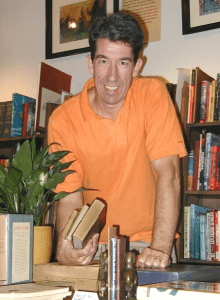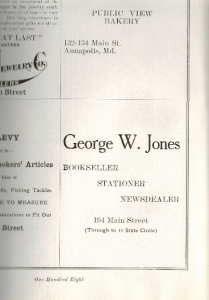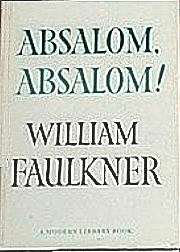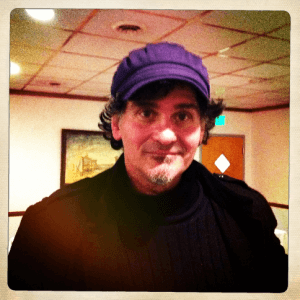“All booksellers are connected by some cosmic fabric …”
– Rock Toews, bookseller
That fabric, of course, is literature. From yard sales to estate sales, good books and old manuscripts find their way to pre-ordained shelves.
Few tales have illustrated the mysticism under-girding the lives of books better than Cynthia Ozick’s “The Messiah of Stockholm,” a 1988 novella anchored by an old bookseller named Heidi, an unsettled man who reviews literature for a daily newspaper, and the ghost of the great Bruno Schulz, the Polish writer murdered by the Nazis.
In the case of Rock Toews of Annapolis, it’s also a matter of geography.
“I just bought a history of Annapolis published in 1887,” said Toews. “On the inside it says it was bought at Jones Bookstore on Main Street.”
And now, Toews and his inventory of 4,000 books is moving to the early 20th century site of bookman, stationer and news dealer George W. Jones at 194 Main Street; hauling his treasures from the old Henry B. Myers hardware store on West Street to the Public Sales Office.
The migration of nautical and military tomes together with books on Honest Abe, tales of old Annapolis and a 1939 booklet on the McCormick Spice Co. when it was still at the Inner Harbor began immediately after the 4th of July holiday.
“We’ll open up at the new shop about August 1,” said Toews, 46, a native of the San Joaquin valley, birthplace of author William Saroyan [1908-to-1981].
Before he got mixed-up with books and moved east for a wider variety of American history, Toews managed apartments in Hollywood and once counted the actor Crispin Glover as a tenant. A former manager of the Barnes & Noble in Annapolis and a trained accountant, Toews surprised himself by how much he enjoys playing shopkeeper.
As bookselling becomes more and more geared to on-line sales – with some shops selling a book for a penny plus shipping to promote their business – Toews is increasingly less computerized. He wants to meet his customers, talk to them; learn what he can.
“It’s interesting that books are dead and I’m bringing a bookshop back to the space where George Jones produced and sold souvenir books of Annapolis,” said Toews, noting that Jones also ran a lending library.
-o-
“A lot of a book’s value is derived from the writer’s standing as an author …”
– Rock Toews
Several boxes the Big Three of 20th century American letters – Hemingway, Fitzgerald and Faulkner – will follow Toews from West to Main.
Hemingway, along with Cormac McCarthy is among Toews’ favorites and he recently re-read McCarthy’s “Blood Meridian,” which super critic Harold Bloom has called “the greatest single book since Faulkner’s ‘As I Lay Dying.’”
“He makes it look easy,” said Toews of McCarthy. “And you know it’s not.”
[Buyers beware, Toews cautioned. Unscrupulous book mongers try to sell signed copies of Cormac classics. But the author is a notorious “non-signer” and alleged signatures are often forgeries. Even without a legit John Hancock, first editions of “Blood Meridian” can bring up to $6,000.]As happens every generation or so, Fitzgerald is riding high this year with yet another Hollywood remake of “The Great Gatsby,” this one starring Leonardo DiCaprio in the title role.
Toews noted that first editions of Gatsby – especially those with dust jackets in fine condition – can sell for a quarter-of-a-million dollars and has been listed as high as $300,000. That’s about one-eighth the cost – in Roaring 20s dollars – of Jay Gatsby’s Long Island mansion in the fictional village of West Egg.
And with Faulkner, whose fictional Mississippi county of Yoknapatawpha lies some 900 miles south of Annapolis, nothing is easy. Each paragraph, sometimes each phrase or sentence, is like breaking off a hard piece of old taffy and chewing it until the juices flow anew. In time [time tampered with, distended], some part of the picture starts to make sense.
The “old Colonel” was my summer reading this year as I trudged through the hundred miles of ruined fields and dark, stifling hallways of “Absalom, Absalom!”
I have read “The Sound and the Fury,” and “Light in August,” and waded into “Abslaom!” after I saw another writer whom I admire carrying it during my August 2012 road trip from Los Angeles back home to Baltimore.
Stopping in San Francisco to visit the poet Alan Kaufman (author of the 2011 memoir “Drunken Angel”) I noticed he carried a familiar text (in size and maroon binding) that marked it as a volume from the Modern Library.
Sitting in a café in the Sunset neighborhood, I asked which title it was, Kaufman held up the spine – “Faulkner – ‘Absalom, Absalom!” – and said he was re-reading the saga of Sutpen’s Hundred.
“Why?”
“To remind me what literature is,” said Kaufman.
-o-
The next day, the 35th anniversary of the King’s death [Presley’s Tupelo birthplace a mere 50 miles east of Faulkner’s Oxford hometown], I found the same edition of “Absalom” as Kaufman’s in a used bookstore north of S.F. in Auburn, California.
At $10 – with marking throughout in green ink – it was overpriced. Lucky book hounds can find the same thing at yard sales (particularly in neighborhoods where a lot of kids suffered intro to American literature courses) for two bits.
But I like supporting independent bookstores [the way others feel good about dropping change in the raw palms of the homeless] and was charmed by the fact that the copy was indeed the very edition as Kaufman’s, which he said he has owned for some 30 years.
“Faulkner gave me the sense that to be a disreputable shiftless hobo-bum walking around beltless and unemployed because all you want to do – can do, will do – is write is not only only OK but actually honorable,” said Kaufman, who has known a strata of street life – indeed the gutter – that Faulkner never did.
“His sonorous ceaseless spellbinding sentences still strike me as the bottom-line in literary artistry,” said Kaufman, noting that, as with Joyce, Faulkner “accesses the unconscious through language.”
“And,” he continued, “I still cleave to his belief that to seek respectability as an artist or citizen is antithetical not only to the making of art but to decency itself – a form of low-down cowardice.”
Back in Baltimore, I asked the hometown poet Afaa Michael Weaver (over sumptuous crabcakes at Ikaros in Greektown) if he believed Faulkner’s unflinching examinations of Southern society pre-World War II was tinged with racism.
“To say that would be to say he was willful and maybe even reckless and I don’t think that’s the case,” said Weaver, who rose from waterfront factory worker to professor and is heralded by many as the African-American Walt Whitman.
“He might have missed some nuances that only a black person would know, but he wasn’t out to do damage and racism is a tricky thing when you look back into time. He didn’t exactly include the whole of a black character, but how could he know?”
Perhaps the Canadian Shrevlin McCannon knew. A Harvard boy who fills in a good one-fifth of “Abaslom, Absalom!” with prophetic conjecture, “Shreve” ends the book with talk of Jim Bond, a slave who was the great-grandson of uber-protagonist and plantation owner Thomas Sutpen.
“I think that in time the Jim Bonds are going to conquer the western hemisphere …. Now I want you to tell me just one thing more. Why do you hate the South?”





It seems important, to you, to divide the country off by words and geography. Fine.
As a North Easterner- NYC to be specific- thinking about your quest—my first response would be: who is better with words than Alan Kaufman? Words, used in a NY kind of way. Words in a NY kind of way, used everyday. Phrases. Orders. Permits, Friendship, business, he is a part the way.- if one choses. Onward. thanks clayton
In a world of Amazon and Barnes and Noble, it’s refreshing to know there are booksellers out there who still know about, of all things, BOOKS!
I first met Rock Toews not long after I acquired the Book Miser shop in Fell’s Point, back in 1993. He and I have been back in contact via Facebook this year, and it gladdens my heart to see him succeeding in a trade where so many of us made noble failures.